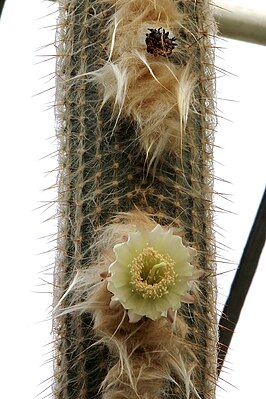Espostoa melanostele
| Espostoa melanostele | ||||||||||||
|---|---|---|---|---|---|---|---|---|---|---|---|---|

Espostoa melanostele |
||||||||||||
| Systematics | ||||||||||||
|
||||||||||||
| Scientific name | ||||||||||||
| Espostoa melanostele | ||||||||||||
| ( Vaupel ) Borg |
Espostoa melanostele is a species of plant in the genus Espostoa from the cactus family(Cactaceae). The specific epithet melanostele means 'black columnar, black stalked'.
description
Espostoa melanostele grows branching from the base. The shrubs reach heights of up to 2 meters. The individual shoots are up to 10 centimeters in diameter. They have about 18 to 25 ribs . Very numerous and closely spaced areoles with dense whitish to brownish hairs that can be up to 1 centimeter long cover the entire shoots. The 1 to 3 central spines, which are initially yellow, turn black over time. They have a length of up to 10 centimeters. The 40 to 50 radial spines, on the other hand, are only 0.5 to 1 centimeter in size. The cephalium is whitish, yellowish or brown and about 50 to 70 centimeters long. It includes up to 8 ribs.
The flowers are bell-like white, 5 to 6 inches long and up to 5 inches in diameter. The pericarpel is covered with tiny scales; the tube with larger hairy scales. The fruits are greenish white to even reddish. They are 5 inches long and large in diameter.
Distribution, systematics and endangerment
Espostoa melanostele is distributed from the north to the center in Peru on the western slopes of the Andes, in a narrow strip parallel to the coast at altitudes between 800 and 2500 meters.
It was first described as Cephalocereus melanostele in 1913 by Friedrich Karl Johann Vaupel . John Borg placed the species in the genus Espostoa in 1937 .
Synonyms are the following described species and varieties: Cephalocereus melanostele Vaupel (1913), Binghamia melanostele (Vaupel) Britton & Rose (1920) (incorrect name, ICBN article 11.4), Pseudoespostoa melanostele (Vaupel) Backeb. (1934), Pilocereus haagei Poselg. ex Rümpl. (1885), Espostoa haagei (Poselg. Rümpl ex.) F.Ritter (1958), Pseudoespostoa melanostele var. Inermis Backeb. (1951), Espostoa melanostele f. inermis (Backeb.) Krainz (1964), Espostoa haagei var. borealis F.Ritter (1981) ( nom.inval . ICBN -Article 36.1) and Espostoa haagei var. samnensis F.Ritter (1981) ( nom.inval . ICBN - Article 36.1).
In the Red List of Threatened Species of the IUCN , the species is listed as " Least Concern (LC) ". H. listed as not endangered.
proof
literature
- Edward F. Anderson : The Great Cactus Lexicon . 2nd Edition. Eugen Ulmer KG, Stuttgart 2011, ISBN 978-3-8001-5964-2 , pp. 281-282 .
- Antonio Gómez Sánchez: Enciclopedia ilustrada de los cactus y otras suculentas: (descripción de las especies, habitat y cuidados de cultivo) . Floramedia Espana SA, Valencia 2006, ISBN 84-89347-56-5 , p. 60 .
Individual evidence
- ^ Botanical yearbooks for systematics, plant history and plant geography . Volume 50, number 2-3, Beiblatt 111, Leipzig 1913, pp. 12-13 (online) .
- ↑ John Borg: Cacti . 1937. p. 112.
- ↑ Espostoa melanostele in the IUCN Red List of Threatened Species 2013.2. Posted by: Cáceres, F., Ostalaza, C. & Roque, J., 2011. Retrieved March 9, 2014.